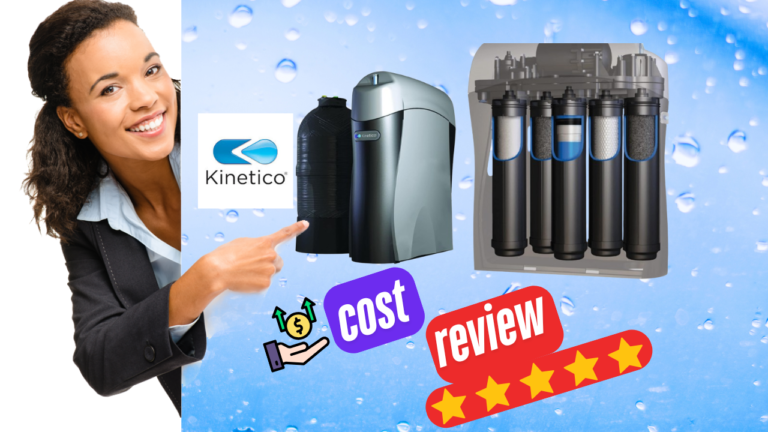Understanding the Salty Taste in Softened Water: Causes and Solutions
Did you know that nearly 85% of U.S. households use some form of water softening? If you've noticed a salty taste in your softened water, you're not alone, and it can be traced back to the sodium ions introduced during the softening process. However, factors like your plumbing materials and local water conditions can also play a role. You might be wondering what you can do to improve the taste and maintain water quality without sacrificing effectiveness. There are several strategies worth considering that could potentially transform your experience with softened water.
Key Takeaways
- The salty taste in softened water often results from sodium ions added during the ion exchange process of water softening.
- Testing water for sodium levels can help identify if the salty flavor is due to high sodium concentration or other factors.
- Adjusting the regeneration settings of water softeners can reduce sodium usage and minimize the salty taste in softened water.
- Alternative softening methods, like potassium-based or magnetic softeners, can effectively reduce saltiness while maintaining water quality.
- Regular maintenance and accurate calibration of water softening systems ensure optimal performance and prevent unnecessary salt accumulation.
What Is Water Softening?
Water softening is a process that removes minerals like calcium and magnesium from hard water, making it gentler on your plumbing and appliances.
When you deal with water hardness, the presence of these minerals can lead to scale buildup in pipes and on fixtures, reducing their efficiency and lifespan. By softening your water, you're enhancing the quality and longevity of your home systems.
The most common method for softening water involves ion exchange. In this process, hard water passes through a resin bed that captures calcium and magnesium ions, replacing them with sodium ions.
This exchange not only reduces water hardness but also prevents the unpleasant side effects of hard water, such as soap scum and dull laundry. It's important to understand how these minerals impact your daily life; they can affect everything from your shower experience to the effectiveness of your dishwasher.
Ultimately, softening your water is a smart investment. It protects your home, improves your cleaning products' effectiveness, and can even make your skin feel better after a wash.
How Sodium Affects Taste
Sodium ions play a significant role in how we perceive taste, especially when it comes to softened water.
You might notice that the presence of sodium can enhance flavors, making water taste saltier than untreated sources.
Understanding these characteristics can help you appreciate the variations in taste perception that softened water brings to the table.
Sodium Ion Characteristics
Many people mightn't realize that sodium ions play a significant role in how softened water tastes. When water is softened, sodium ions replace calcium and magnesium ions, which are typically responsible for hard water's mineral flavor. This replacement can lead to noticeable sodium effects on taste, creating a distinctly salty flavor that may not appeal to everyone.
Sodium sources in softened water primarily come from the salt used in the water softening process. The more sodium present, the stronger the salty taste can become. For those who are sensitive to sodium or are on a low-sodium diet, this change in flavor can be concerning.
Interestingly, sodium is known for enhancing certain flavors, which means that while you might notice an increase in saltiness, it can also improve the overall taste experience. However, you might find that the salty notes can overpower the natural flavors of the water.
Understanding sodium ion characteristics helps you appreciate why softened water tastes different and allows you to make informed choices about your water consumption. If the taste bothers you, consider alternatives, such as reverse osmosis systems, to achieve a more neutral flavor.
Taste Perception Variations
Taste perception varies considerably among individuals, especially when it comes to sodium's influence on flavor. You might find that some people enjoy the salty taste in softened water, while others find it off-putting. This variation stems from individual differences in taste perception, which can be affected by genetic factors, previous experiences with salty foods, and even cultural background.
When you consume softened water, your palate may undergo flavor adaptation. This means your taste buds can adjust to the sodium levels over time. If you frequently drink softened water, you might begin to appreciate its flavor more, as your brain learns to associate it with hydration and refreshment. Conversely, if you're not accustomed to it, that initial salty taste might be overwhelming.
Other factors like temperature and the presence of other flavors can also influence how you perceive sodium. For instance, colder water might taste less salty than warm water.
Understanding these nuances can help you adapt your palate and make more informed choices about your drinking water. Ultimately, recognizing your taste preferences can lead to a more enjoyable experience when consuming softened water.
Common Causes of Salty Taste
Experiencing a salty flavor in softened water can be puzzling. You might be wondering where that taste is coming from. One common cause is the use of sodium-based water softeners. These systems replace hard minerals like calcium and magnesium with sodium, which can raise the sodium concentration in your water.
If you're sensitive to salty sources, even a small increase can lead to noticeable taste changes, surpassing your taste thresholds.
Another potential culprit is the plumbing in your home. Older pipes, particularly those made of lead or galvanized steel, can corrode and leach metals into your drinking water. This contamination can sometimes mimic a salty flavor, making it hard to pinpoint the exact cause.
Additionally, if you've recently experienced heavy rainfall or flooding, the influx of water can disrupt your treatment system, causing fluctuations in taste and quality.
Finally, consider your local water source; nearby saltwater bodies or industrial activities may impact the overall mineral balance of your water supply. Understanding these common causes can help you identify and address the salty taste in your softened water effectively.
Testing Your Water Quality
When it comes to ensuring your water is safe and pleasant to drink, testing your water quality is fundamental. Regular water testing gives you a clear picture of what's in your water, helping you identify any potential issues like that salty taste.
You can conduct a quality assessment using either DIY test kits or professional services. DIY kits are convenient and can measure various parameters, including hardness, pH, and sodium levels.
If you prefer a more thorough analysis, hiring a professional service can provide detailed insights into contaminants that might affect your water's flavor and safety.
Keep in mind the importance of testing your water regularly, especially if you've recently installed a water softener or if you notice changes in taste. Understanding the results of your tests is essential; high sodium levels can lead to that undesirable salty flavor.
Once you've identified any issues, you can take appropriate action, whether that's adjusting your water softener settings or exploring alternative filtration systems.
Regular quality assessments are important for ensuring your water remains safe and enjoyable for you and your family.
Health Implications of Sodium
Sodium, a key component in softened water, can have significant health implications if consumed in excess. While sodium is essential for bodily functions, such as maintaining fluid balance and nerve transmission, too much dietary sodium can lead to health issues.
If you're consuming softened water regularly, it's important to take into account your overall sodium health. Most health organizations recommend keeping daily sodium intake below 2,300 milligrams, but many people exceed this limit without realizing it. High sodium levels can contribute to hypertension, which raises your risk for heart disease and stroke.
If you have existing health conditions, such as kidney disease or hypertension, consuming softened water may exacerbate your situation. This is particularly true if you rely on softened water for cooking and drinking.
To make informed choices, you should be aware of your total sodium intake, including that from softened water. Reading food labels and understanding where sodium lurks in your diet can help you manage your levels better.
Staying mindful of sodium health is essential, especially if you're trying to maintain a balanced diet and promote overall well-being.
Solutions to Reduce Salt Taste
If you're finding the salty taste of softened water unappealing, there are effective solutions to evaluate.
Exploring alternative water softening methods can markedly improve the flavor, while adjusting regeneration settings on your current system can also make a difference.
Alternative Water Softening Methods
Water softeners are essential for many households, but the salty taste that often comes with softened water can be off-putting. If you're looking for alternatives, consider magnetic softeners and template softeners. These methods can help you enjoy softer water without the unwanted saltiness.
Here's a quick comparison of these alternative methods:
| Method | Description |
|---|---|
| Magnetic Softeners | Use magnetic fields to alter mineral structure, reducing hardness without adding salt. |
| Template Softeners | Employ a special media that captures hardness minerals, allowing for soft water without salt. |
| Reverse Osmosis | Filters water through a membrane, removing minerals and impurities for a fresh taste. |
| Potassium-based | Uses potassium chloride instead of sodium to soften water, decreasing salty flavor. |
| Distillation | Evaporates water and condenses it, removing minerals and resulting in pure water. |
Adjusting Regeneration Settings
Adjusting the regeneration settings on your water softener can greatly help reduce the salty taste that often accompanies softened water.
To start, consider the regeneration frequency. If your system regenerates too often, it may be using excessive salt, leading to that salty flavor. You'll want to find a balance between effective softening and minimizing salt usage.
Next, check the ideal settings for your specific water softener model. Most units allow you to customize the amount of salt used during each regeneration cycle. By fine-tuning these settings, you can cut down on salt while still maintaining efficient water softening. Aim for a regeneration frequency that suits your household's water usage—usually, every 7 to 14 days is best for most families.
Additionally, keep an eye on your water hardness level. If you find that your water softener is set to regenerate based on an inaccurately high hardness reading, it may be time to recalibrate.
Regularly testing your water and adjusting settings accordingly can lead to better tasting water and less salt in your system. You might be surprised at how these small adjustments can greatly improve your water quality!
Alternatives to Traditional Softeners
While traditional water softeners effectively reduce hardness, they often leave a salty taste that some homeowners find unappealing. If you're looking for alternatives, consider magnetic softening and template softening.
Magnetic softening uses magnets to alter the physical properties of hard water. This process prevents minerals like calcium and magnesium from forming scale without adding sodium. It's environmentally friendly and doesn't require any chemicals or salt, making it a popular choice for those wanting to avoid that salty aftertaste.
Template softening, on the other hand, employs a unique technique that transforms hardness minerals into harmless microscopic crystals. These crystals won't stick to pipes or appliances, reducing scale buildup without removing essential minerals from your water. This method also doesn't add any salt, ensuring your water remains pure and tasty.
Both options can be effective in treating hard water without the drawbacks of traditional systems. By exploring these alternatives, you can enjoy soft water without compromising on taste, giving you the best of both worlds.
If you're considering a switch, weigh the pros and cons of each method to find what works best for your home and lifestyle.
Frequently Asked Questions
Can Softened Water Affect My Pets' Health?
Softened water can affect your pets' health by altering their hydration levels. Higher sodium intake from softened water might not be ideal for some pets, especially those with specific dietary restrictions or health issues. Always consult your vet.
How Does Softened Water Impact Plant Growth?
About 30% of plants struggle with nutrient absorption in softened water. It can alter soil health, affecting essential minerals. Monitor your plants closely, as softened water might hinder their growth and overall vigor.
Is Salty Taste Consistent Across All Softened Water Systems?
Salty taste isn't consistent across all softened water systems. You might notice taste variations depending on the specific system's method and settings. It's always good to check your system's specifications for more accurate information.
What Are the Environmental Impacts of Water Softening Systems?
Did you know that nearly 85% of U.S. households use water treatment systems? These systems can affect environmental sustainability by increasing sodium levels in waterways, impacting local ecosystems and potentially harming aquatic life.
Can I Use Softened Water for Cooking and Drinking?
You can use softened water for cooking and drinking, but be mindful of its taste. If you prefer less salty flavors, consider using unsoftened water for cooking, as it aligns better with many cooking preferences.
Conclusion
To sum up, the salty taste in softened water can be a surprising twist, much like biting into an unexpectedly salty snack. By understanding the role of sodium and exploring solutions like adjusting settings or opting for potassium-based softeners, you can reclaim the invigorating purity of your drinking water. With a bit of effort and knowledge, you'll transform your water experience, ensuring it's not only palatable but also healthier for you and your family.







